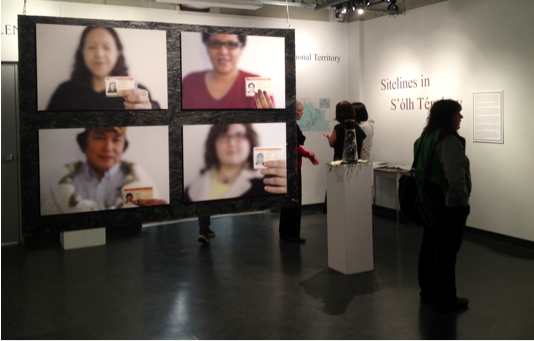By Kate Nickelchok (Contributor) – Email
Print Edition: April 11, 2012
The Sitelines in S’olh Temexw gallery opening on March 30 saw the culmination of a year’s worth of work from the Lens of Empowerment Project at UFV. During the year, I had the privilege to learn alongside the nine other women and one man who made up the Lens of Empowerment (LOE) cohort: an intergenerational, intercultural collective tasked with exploring women’s citizenship and identity in Stó:l? territory through the lens of film and photography.
Around 100 UFV and Stó:l? community members attended the Sitelines gallery opening. The exhibit featured select artwork and documentary films produced by the class over two semesters. UFV senior advisor on Indigenous Affairs, Shirley Hardman, kicked off the gallery opening with an acknowledgement of Stó:l? traditional territory (S’olh Temexw) and a powerful welcoming song. We were fortunate to have Hardman, along with a variety of Stó:l? elders and teachers, act as guest lecturers throughout the Lens of Empowerment courses.
The event began in UFV’s B building gallery where it was emceed by Sarah Ciurysek, one of LOE’s two Visual Arts instructors, with help from students Michelle Auton and Jennifer Janik. Ciurysek explained the Lens of Empowerment as being an experimental cohort brought together by UFV’s Visual Arts department and Indigenous Affairs office. After introductions, guests were then warmly welcomed to view the work of the student artists and give them feedback.
Later in the program, the crowd migrated to the UFV lecture hall in B101 for Sitelines’ documentary film screening. The featured short films were either character studies of a place or biographies/autobiographies on women in S’olh Temexw. Similar to Sitelines’ gallery work, the films captured stories from a diversity of cultural communities in the Fraser Valley. Imroze Deol presented a sleek, stylized film on gender equality as told by first generation Sikh women in Abbotsford. Deol’s fast-paced edits and bangra/hip hop soundtrack was visually very different from Trina Hunt’s touchingly personal, diary-style film on powwow dancing. However eclectic, all films were united under the theme of women’s experiences.
“Women are mothers, teachers, aunties and mentors,” explained Shirley Hardman in an interview with UFV Today. “The stories of every woman in Stó:l? territory have an impact on nation. The telling of these stories through photography and video strengthens connections and nurtures awareness for coming generations because storytelling connects us to the land, and to each other.”
As for myself, I personally signed up for Lens of Empowerment as a woman struggling to position myself within the feminist movement and greater social justice issues in Stó:l? territory. For my classmates and me, LOE provided a safe space to explore themes of identity, gender, culture, race and colonialism through personal stories made manifest in film and photography.
Lens of Empowerment was born from the philosophy that individual empowerment, when captured in art, will lead to wider community transformation. “It is fantastic to be part of something larger than ourselves and so community-based,” said LOE’s video instructor Stephanie Gould on the project blog. “We have got to know each other much better than one does in a normal course.”
“This was the first set of classes where I learned everyone’s names!” said student artist Andrea Smith. “I think that Sitelines gives the community an opening to a much larger conversation.”
The conversation around gender and settler-Indigenous inequalities is not always an easy one, but as Sitelines proves, it is immensely important. Sitelines in S’olh Temexw makes visible the invisible constructs of power and privilege through art and turns the students’ individual works into catalysts for communal dialogue.
Instructor Stephanie Gould summed up the impact of Sitelines in an interview for UFV Today: “Across differences in culture, gender, and experience, this group of students has brought focused attention to stories of place, and women’s stories, through lens-based art. This attentiveness through art to one another’s stories is as critical to understanding our diverse local communities as it is communities and home places across the world.”
Sitelines in S’olh Temexw will be on display in B136 from 9 a.m. to 5 p.m. on weekdays until April 11. Further showings are being planned for the UFV Chilliwack campus and Loughborough, England.



